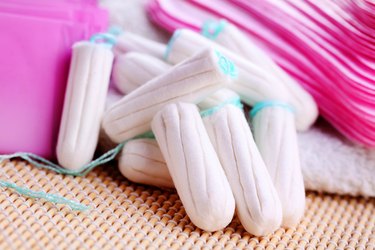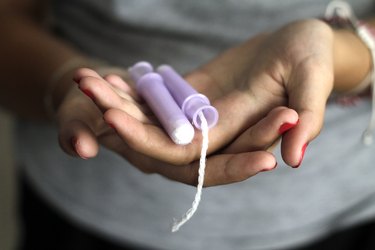
If your child recently got their first period, the decision to use tampons for the first time can feel like a big step — for both of you.
You might wonder if they're really old enough or able to handle the responsibility of using tampons, which are both normal questions.
Video of the Day
Video of the Day
Here, experts weigh in on what you need to know about figuring out whether your child is ready, the myth about tampons and virginity and how to help kids or teens get the hang of using tampons for the first time.
How Tampons Work
Tampons are cylinder-shaped products inserted into the vagina to absorb blood or vaginal secretions during menstruation. They're held in place by the muscles of the vagina and stay inside until they're taken out. They can be used during any kind of sports or activities, including swimming. You shouldn't typically be able to feel a tampon when it's inserted correctly, according to Planned Parenthood.
Most tampons are made of a blend of cotton with synthetic fibers or cotton alone. Some come with plastic or carboard tube applicators that make them easier to put in; others are inserted using just your fingers.
What's the Appropriate Age for Tampons?
Any person who has a period can use a tampon, including someone who has just started menstruating. "It is totally up to each individual to decide. There is no right or wrong age," says Wiyatta Freeman, MD, an ob-gyn with McGovern Medical School at UTHealth Houston.
Instead, it's about what a person feels comfortable with. Tampons can be a good choice for those who are active or like to go swimming, for example. And because they're small, they're easy to tuck into a pocket or bag if discretion is a concern.
Pads, on the other hand — including reusable pads — may feel a little easier to use early on, but they can sometimes be bulky, which may limit the activities you're able to engage in and be more obvious to cart around.
Period underwear and menstrual cups or discs are other options to consider.
"Think about what may best fit you. I would try different period products and figure out what works for you," Dr. Freeman says.
It's important to know, too, that tampons are appropriate for virgins or those who are sexually active. While tampons (and other activities, like playing sports) can cause the hymen to stretch or tear, inserting one doesn't mean that a person has lose their virginity, according to Nemours.
"Technically, loss of virginity is considered penetration by any sexual activity, penile or digital," Dr. Freeman explains. "The state of your hymen has nothing to do with virginity."
How to Know When Your Child Is Ready for Tampons
There's no one-size-fits-all age for tampons. Instead, it's a good idea to talk about all of the options with your child and encourage them to decide what feels right.
"Any time after someone's first period, the choice to use a pad, tampon, menstrual cup or period panties is completely up to the menstruating person," says Erin Flynn, DNF/FNP, a family nurse practitioner with The Pill Club.
Flynn encourages parents to begin talking about periods and period options with 7- and 8-year-olds, "so they're not surprised or scared when their first period happens."
If your child tells you they're ready to start using tampons, talk through their choice together and share advice and resources on how to get started and use tampons safely, recommends the Cleveland Clinic.
"It's important to meet the moment with resources about anatomy and education about tampon safety practices, while using language that normalizes using tampons if it's best for their lifestyle," says Flynn.
How to Get Started With Tampons
Using a tampon for the first time can be a little intimidating. Walking your child through the process can help them feel more confident about getting started.
- Do a quick anatomy brush-up. Talk with your child about the different parts of the vulva (the outer part of the female genitals) and where tampons are supposed to go. "A lot of sex education skips the part where women have three holes, and only one is meant for tampons!" Flynn says. Planned Parenthood has good resources you can look at together.
- Pick the right tampon. Tampons come in light, regular and super absorbencies. Choosing the lowest absorbency that will last for a few hours will feel the most comfortable, reminding your child that they may need to change it more often on heavy flow days. New users often find that tampons with applicators are easier to insert.
- Try it on a heavy period day. The tampon may be easier to insert on a day when your flow is heavy, says Nemours.
- Get in a comfortable position. Insertion is easier when you're in a squatting position, like sitting on the toilet, Flynn says. Standing with one leg up works too. Your child can experiment with positions to see what works best for them.
- Gently insert the tampon. Flynn recommends placing two fingers at the base of the applicator and guiding it into the vagina at a slight angle (parallel to the thigh) until the top of the tampon is fully inserted. "Then gently push the end of the applicator towards the vagina to release the tampon into the vagina canal," she says.
- Encourage your child to relax. "Clenching can make it harder to insert the tampon, and letting nerves get the best of them can result in the vaginal canal becoming dry and making insertion difficult or impossible," Flynn says. If needed, try putting a little bit of lubricant (like K-Y Jelly) on the tip of the applicator, Planned Parenthood recommends.
- Remove the tampon if it isn't comfortable. You shouldn't be able to feel a tampon if it's been inserted correctly. If it doesn't feel right, encourage your child to take the tampon out and try a new one. "Gently pull the string down to remove it," Flynn says.
- Change the tampon regularly. That's typically every 4 to 8 hours, but no longer than 8. It's OK for your child to sleep in a tampon, but they should put it in right before bed and change it as soon as they wake up, Planned Parenthood says.
- Be reassuring. Remind your child that it can take some time to get the hang of using tampons. But the more they practice, the easier it'll get. Let them know, too, that they can come to you with questions any time.
Risks of Tampons
It's important to let your child know that tampon use can increase the risk for toxic shock syndrome or TSS, a rare bacterial infection that can be life-threatening. Using the lowest possible absorbency and changing tampons regularly (at least every 4 to 8 hours) can reduce the risk, per the Mayo Clinic.
Your child should also let you or another adult know if they thinks they're experiencing possible TSS symptoms, which can include a sudden high fever, vomiting or diarrhea, a sunburn-like rash, confusion, muscle aches, headaches or redness around the eyes, mouth or throat. These symptoms warrant immediate medical attention.
- Planned Parenthood: "How do I use tampons, pads, period underwear, and menstrual cups?"
- KidsHealth by Nemours: "Can I Use Tampons if I'm a Virgin?"
- Cleveland Clinic: "How To Teach Your Teen To Use a Tampon"
- Planned Parenthood: "What are the parts of the female sexual anatomy?"
- Mayo Clinic: "Toxic Shock Syndrome"
Is this an emergency? If you are experiencing serious medical symptoms, please see the National Library of Medicine’s list of signs you need emergency medical attention or call 911.


